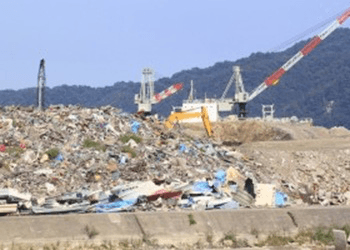Clay Soil Aided Devastating Japan Quake In 2011
An extremely thin layer of clay sediment below the ocean floor is a primary cause of the huge tsunami associated with the 2011 Japan earthquake, according to research by an international team of scientists that include a Texas A&M University professor.
Fred Chester, holder of the David Bullock Harris Chair in geology at Texas A&M and one of the country’s leading experts on the structure of seismic faults, helped author three papers on the March 11, 2011 quake that appear in the current issue of Science magazine.
Using the deep sea drilling vessel Chikyu from the Integrated Ocean Drilling Program (IODP), Chester and an international team of geoscientists participated in the drilling of three boreholes in the Japan Trench about 150 miles east of Japan about 13 months after the quake and giant tsunami it triggered devastated the country.

The researchers were able to locate, sample and place sensitive instruments along the Tohoku earthquake fault, which is the tectonic plate boundary between Japan and the Pacific plate. The variety of data reported in Sciences how that the fault consists of a very thin layer of water-swelling clay that acts as a form of lubricant during an earthquake slip.
“Apparently, the slippery clay lining of the fault minimizes any braking action once the fault starts to move,” Chester explains. “This likely contributed to the very large offset of the seafloor at the trench that spawned the tsunami. It was more slippery than anyone had believed.”
The Tohoku quake occurred in a subduction zone, a boundary between two tectonic plates in which one plate is diving beneath another, Chester says. It created a “slip” of about 150 feet, “which in earthquake terms, is among the largest ever measured, and it was unexpected by many earthquake scientists that the fault ruptured all the way to the seafloor,” he notes.
By any measure, the Tohoku quake and giant tsunami rank among the most devastating and costly natural disasters in recent history.
At 9.0 magnitude, it was the largest quake ever to hit Japan and one of the five largest magnitude earthquakes worldwide since accurate recording was started in about 1900. It killed at least 15,800 people, most of them from drowning, displaced more than 340,000 people and damaged more than 600,000 homes or buildings in Japan.

It severely damaged and resulted in meltdown of three of Japan’s largest nuclear reactors, and the World Bank estimated damages from the quake at $235 billion, making it the costliest natural disaster in history. So large was the quake that it resulted in more than 1,000 aftershocks, at least 80 of those of magnitude 6.0 or greater.
The drilling expedition resulted in a number of record achievements in ocean drilling. Although several similar drilling expeditions had sampled subduction zones before, never before has a seismic fault been drilled and sampled after such a large earthquake or at such great depths. Because of the depth of the Japan Trench, the drill sites used by the team were among the deepest ever, more than four miles deep to the ocean sea floor and then another 2,700 feet underneath it.
“We found that the fault itself is very thin, only about 15 feet thick in the area sampled,” Chester adds. “In comparison, the San Andreas fault in California is more than a mile wide thick in places.”

Also, the instruments placed across the fault, and then later recovered, provide a direct measurement of the strength of the fault. “The extremely accurate measurements of temperature documenting systematic variations of less than a half a degree, provide the first ever determination of the absolute strength of a fault during an earthquake,” Chester notes.
He adds that the findings strongly suggest that the area could be prone to more quakes in the future.
“When an earthquake releases stress in one area, it transfers it to another area,” he says. “So the stress is released in the area of the Tohoku rupture, but it is increased in neighboring sections along the Japan Trench. Hopefully this and other scientific research of the Tohoku event will improve our ability to estimate the probability of other events in the future.”
The project was supported by the IODP, which is funded by a number of entities acting as international partners including Japan’s Ministry of Education, Culture, Sports, Science, and Technology (MEXT) and the U.S. National Science Foundation (NSF).
For more about the expedition, visit the JAMSTEC site.
Media contact: Keith Randall, Texas A&M News & Information Services.





